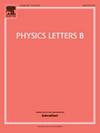Flavor dependence of charged pion fragmentation functions
IF 4.3
2区 物理与天体物理
Q1 ASTRONOMY & ASTROPHYSICS
引用次数: 0
Abstract
We have measured the flavor dependence of multiplicities for and production in semi-inclusive deep-inelastic scattering (SIDIS) on proton and deuteron to explore a possible charge symmetry violation in fragmentation functions. The experiment used an electron beam with energies of 10.2 and 10.6 GeV at Jefferson Lab and the Hall-C spectrometers. The electron kinematics spanned the range , GeV2, and GeV. The pion fractional momentum range was , and the transverse momentum range was GeV/c. Assuming factorization and allowing for isospin breaking, the results can be described by two “favored” and two “unfavored” effective low fragmentation functions that are flavor-dependent. We find each pair converges to a common flavor-independent fragmentation function at the highest W, where factorization is most applicable.
带电介子破碎函数的风味依赖性
我们测量了质子和氘核半包容深度非弹性散射(SIDIS)中π+和π−产生的多重度的风味依赖性,以探索碎片函数中可能的电荷对称破坏。实验使用了杰弗逊实验室和霍尔- c光谱仪的能量为10.2和10.6 GeV的电子束。电子运动学范围为0.3<x<0.6, 2<Q2<;5.5 GeV2和2.2<W<3.2 GeV。介子分数动量范围为0.3<z<0.7,横向动量范围为0<;pT<0.25 GeV/c。假设因子分解并允许同位旋断裂,结果可以用两个“有利的”和两个“不利的”有效的低pT碎裂函数来描述,这些函数依赖于风味。我们发现每一对在最高W处收敛到一个共同的与风味无关的碎片函数,其中分解是最适用的。
本文章由计算机程序翻译,如有差异,请以英文原文为准。
求助全文
约1分钟内获得全文
求助全文
来源期刊

Physics Letters B
物理-物理:综合
CiteScore
9.10
自引率
6.80%
发文量
647
审稿时长
3 months
期刊介绍:
Physics Letters B ensures the rapid publication of important new results in particle physics, nuclear physics and cosmology. Specialized editors are responsible for contributions in experimental nuclear physics, theoretical nuclear physics, experimental high-energy physics, theoretical high-energy physics, and astrophysics.
 求助内容:
求助内容: 应助结果提醒方式:
应助结果提醒方式:


